Wooden Planes and All Metal Ones – What’s the Difference Anyway?
For more information on planes, see our beginner site Common Woodworking.
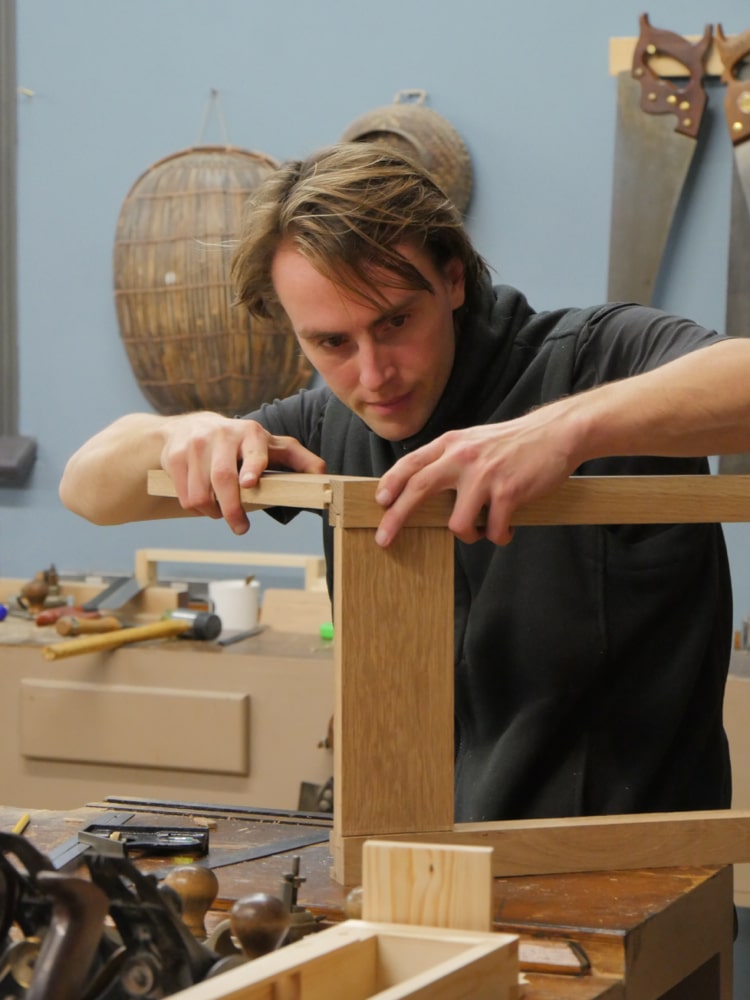
We began making tables last night. Our classes are very fully and very different in that we operate machine-free for all the nine days of the course. That means planing and sawing surfaces and making joinery so everyone develops real skill. Another difference I decided on 25 years ago was that, beyond basically cutting a couple of joints to break the ice, within an our or two our students begin their first fully dovetailed box replete with a lesson on proper hinge setting, bullnosing roundovers and such like that. I’ll photograph the joints from ten boxes, which for some if not most are their very first dovetail joints cut using hand methods.
Most of my students never turned on a machine and have no desire to either. I think that that’s what has made us so very different. Probably 98% of our students, though from around the world, own no machines and never used them. Very different than say my experience the USA where walking into a wood craft store looking for woodworking instruction and guidance and walk out with a tablesaw, planer, drill press, mortise machine, router and a trailer load of accessories à la Norm mode. The difference does make things easy because they then start off on the right foot. We pretty much start a project right off the bat, suing the project as the vehicle for teaching. It’s fast and very effective and it’s worked for over 5,000 woodworkers who’ve been to my courses.
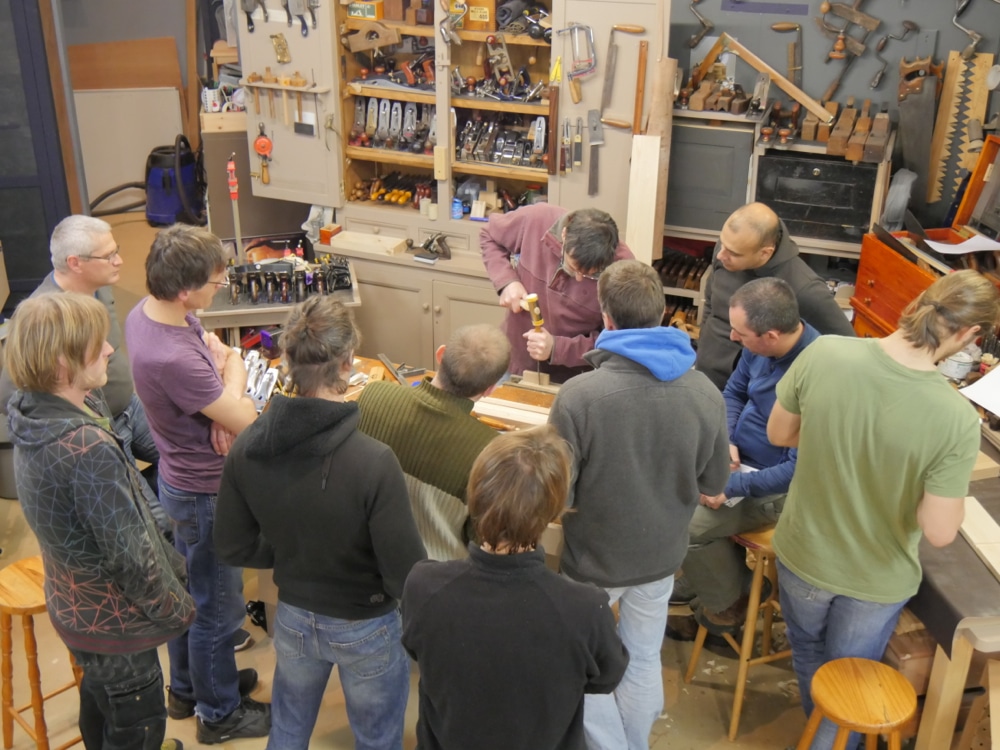
As we discuss the issues of table making I relate my experiences in making tables and the issues seem less sterile that way. Anecdotes keep everyone interested, but it’s much more than that too. We discuss the whys and wherefores surrounding design, like why is a table never higher than so and so no matter the height of the person. What about aprons and tenon lengths and why are the tenons offset or internally mitred or half-lapped? What about the grain and the configuration, colour, growth rings, medullary rays and why do the medullary cause wood to separate? It’s all highly evocative and stimulates everyone to participate at the around-the-bench-sessions. How about ten different ways to chop a mortise or create a tenon with guaranteed accuracy and how do you get shoulders within a thou’ of the other every time?
Then we digress a little…
I was amazed this week by the demographic difference between this class and the others I’ve taught as I blogged yesterday. Here’s one added bit of info I though was significant; of the eleven in the class when we started last Saturday 5 were left handed. The world average for left handers is 10% so here we are at 45% with no left handed benches to offer them. But left-handers are great adapters and they never feel sorry for themselves so they just got on with life and enjoyed the class. It’s harder for me than you might think because I try to given a solution in the left handed language without really speaking it.
…And a Little more…
Someone commented recently about Clifton planes and the engineering standards of the planes Clifton make. I understood what they were concerned about but I do think Clifton planes are well engineered tools. I am often concerned though that planes made on three or four continents now are passing one another as ships and planes (pun intentional) in the night and I wonder how that happened. You now get US made planes made to almost identical standards as UK planes swapping countries and then you get Chinese ones coming in on the triangle to compete. I suppose the UK wants the US market as well as the UK and the US wants the UK market as well as the US. Then of course you have Chinese planes that are not made for the Chinese but for the Woodcraft or Dieter Schmidt customers and so on and so forth. Hard to imagine with German engineering being what it was that it doesn’t have a domestic maker beyond the lower-grade tools made by Kuntz. It’s the same with workbenches these days. Hard to imagine Swedish benches go around the world to woodworkers who buy their wooden workbenches and and so too we see the exchanges of ships in the night again as one US maker supplies a UK catalog and vice versa. It’s all very interesting this thing called global economy. I like the idea of making my own bench in the back garden and seeing it come together from some sticks bought at the local lumber yards. For me and many it’s become all the more real woodworking.
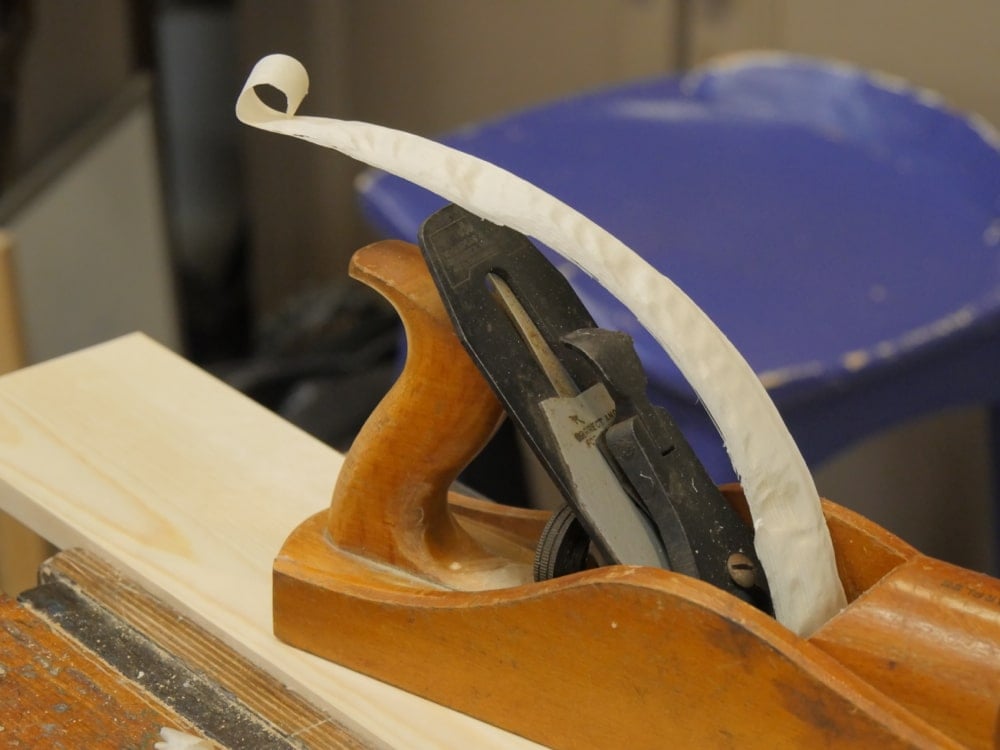
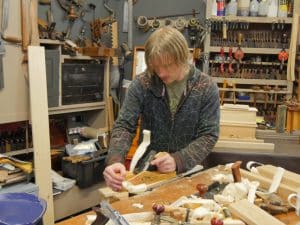
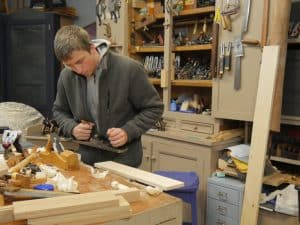
And of course we had fun
Today we tested two planes after I set them up. A wooden-bodied jack, bevel-down, carbon steel, thin iron, 80-90 years old up alongside a new bevel-up, all metal thick ironed A2. Both freshly sharpened and an equal percentage of left and right-handed users in the testing of them both. The outcome was a resounding astonishment from the participants amazed at the ease and effectiveness of a bevel-down, thin ironed, wood-bodied plane. Does that mean one plane is better than the other? No! It means they’re different. They can be applied differently and it means perhaps we might ask why we have so few wooden planes.



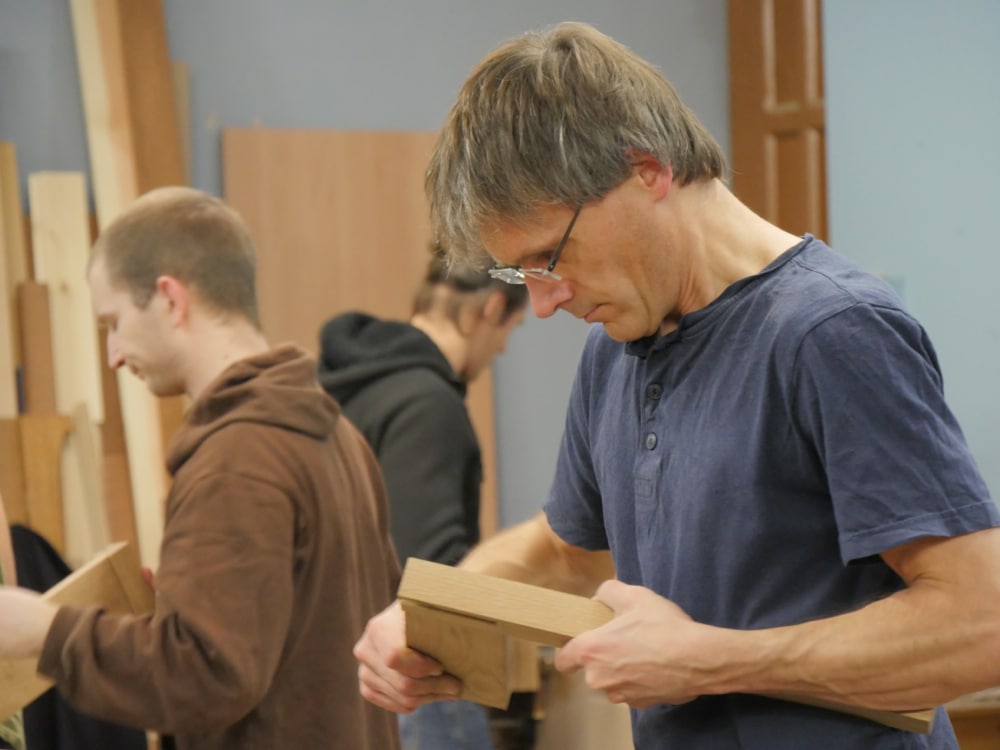
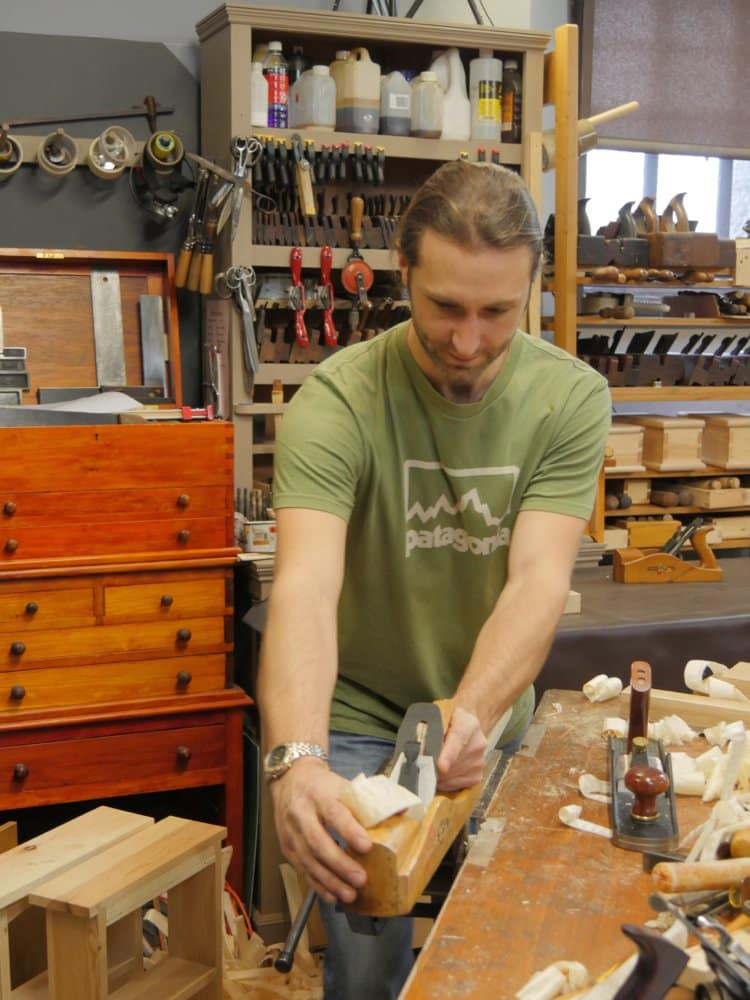
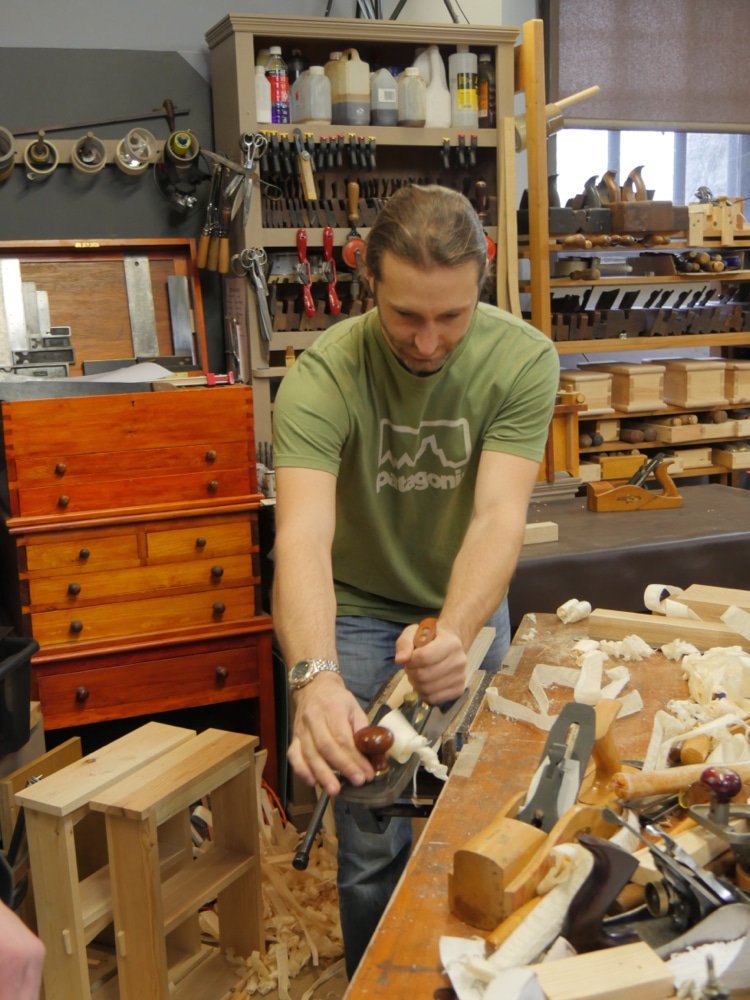
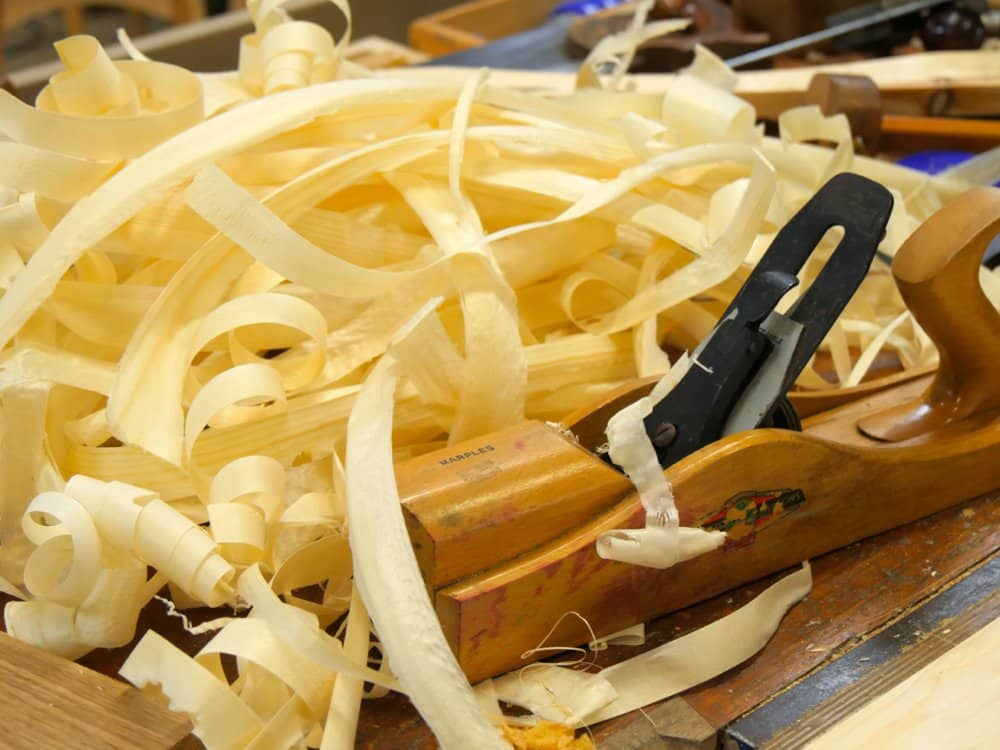
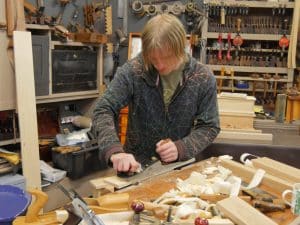
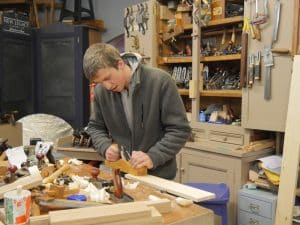
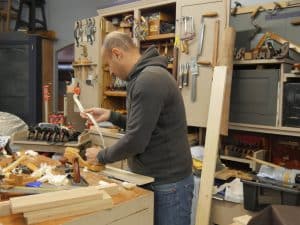
I’m left handed and I think it actually gives me an advantage when I’m watching your videos Paul. I only have to mirror what I see on the screen.
The first reason that comes to mind for why metal and not wood, is that metal is perceived as more durable, and stable than wood. it could also be a “heft” factor as well. Not owning a wooden plane i feel like the metal ones would weigh more for a similar sized plane.
Yes, heft is definitely seen as a bonus by today’s woodworker but in the not too distant past weight was seen as a problem and it was hard to get craftsmen to accept the all metal ones. It took Stanley forty or more years of making transitional planes even though they had the full cast iron models in the 1860’s. Wood on wood simply glides and wooden soles stay flat and true usually too. This is why even today many European countries still prefer wooden soled planes and never followed the cast models of the USA and Great Britain. They weigh in at about half the metal ones, but people don’t believe me when I say they are incredible to use. It’s not really a Luddite thing or nostalgia at all. If it were I would have abandoned my Stanley and Records I suppose.
When it comes to the weight it may be the Goldilocks effect, not too heavy, not to light. When it comes to a harder place to plane the flywheel effect kicks in and the plane keeps on going but if it was much heavier, us older guys like me, I’ll be 69 in 2 months, and you who are smaller that our kids, feel the new Stanley No. 4, yes I bought a Sweetheart about 6 months ago, are much heaver than the older 4’s I have bought on Ebay. I can see where thinning that board for the jointer toolbox would be much more tiring. But for our kids . . .
If your trusty No. 4 would have been the wooden equivalent, do you feel the chip clearance in the sole would have gotten bigger or not?
I love using both wooden and metal planes. It is a joy to use a tool that is over 100 years old and was someones prized possession when it came to working wood.
For those of us who do love the old wood bodied planes, it is of note that there is an upswing of interest here in the US, with books, videos, and classes being offered not just in using them but making new ones-some are replicating 18th century wooden planes, others more modern “Krenov style” planes, but the feeling of using the wooden planes is alluring.
Quote: “Hard to imagine with German engineering being what it was that it doesn’t have a domestic maker beyond the lower-grade tools made by Kuntz.”
I dare say E.C.E. and Ulmia are traditional, local plane makers here in Germany. I can’t say for sure, that they are producing in Germany, but I would guess they do. I have a few of their wooden planes.
I think unfortunately that these makers, like many British makers, have failed to hold the same standards of their forebears, but they can all be worked on to improve the lack of finish to become good lifetime planes. I think that Kuntz has tried to upgrade by producing more modern looking planes following the English Norris-style adjustment Veritas followed with their adjusters in most of their planes. I don’t know if Kuntz is manufacturing in the EU or China. Does anyone else know?
I can’t say whether it was different decades ago, but you’re right to say that the finish can be improved on, the lacquer does not have a nice feel to it. Also I’m not sure what to think of the thick irons (2.6-3.1mm). When I make it to one of your next workshops, I’ll bring along the planes for further examination, if that is of interest.
Us lefties will soon take over the world.
Speaking of wooden planes and German Engineering, what of ECE continental style wooden planes? I have never used one but they do appear to be well engineered and well made… Any thoughts / experiences?
In germany professional woodworkers were and are trained mostly with wooden planes. Metal planes are used mainly by hobbyists because there is more Literature from Overseas for this group where these planes are used. I think it is a little bit like in japan were wooden planes still dominate. Nevertheless the use of planes in professional workshops is in general rare. CNC etc. dominates. For fitting on site the swiss rali plane with interchangeable blades is often used. Ulmia and ECE sell interchangeable blades for their classic planes, too. During apprenticeship wooden planes mainly from ECE or Ulmia are still used. A classic plane set consists of eight planes all wooden bodied, they are Schrupp-, Schlicht-, Doppel-, Zahn-, Sims-, Doppelsims-, Putzhobel and Raubank (Scrub, Jack, Bench, Tooth, Rabbet, Rabett with doble Iron, Smoothing, Jointer). There are planes with adjusters, but traditionally the planes are set with a hammer. The soles are made out of hornbeam or for the more expensive versions out of Lignum Vitae. I have several Planes from ECE and Ulmia and like them all. The only metal planes I use are a record 601/2 a radius plane and a spokeshave. I think we like what we are used to use. I think the Kunz planes beside of spokeshave and radius plane are not very common in germany. ECE and Ulmia have both websites in english: http://www.ecemmerich.de, http://www.ulmia.de.
Sorry for my bad english.
Paul
Paul thanks for providing the links to Ulmia & ecemmerich, I think it is great to see these traditional hand tools still being made today. I recently purchased an old bench on Ebay.de
when I picked it up the guy gave me his fathers set of old ece wooden planes,after cleaning & sharpening I have them working a as they should, they are a pleasure to work with.
ps I think your english is very good.
Grüße aus Ratingen.
Chris
To be fair, Kunz has been manufacturing their “Plus” line of bench planes in cast iron for a while now. I have not used any, but they look like they are trying to compete. The irons are shorter, and have a Norris-style adjuster. There was a review of one of their Plus smoothers in a 2011 FWW, claiming it had “too much” backlash and imprecise lateral adjustment. Paul Sellers might appreciate that the Kunz Plus Smoother is a fairly light plane at 3lb-15oz compared to a Lee Valley or Lie Nielsen.
Yes, I did mention that, but I wasn’t sure if they were made somewhere else like for instance Spear and Jackson tenon saws being sold from Sheffield in the UK and under that banner but being manufactured in Asia. They are sold by one US catalog company under the name European. Irwin Marples another and so on.
Backlash has never really bothered me as it seems to do some. On a regular Stanley I just flick it and it spins for take up in a flash on my own planes and is often better in terms of comfort and also faster than those with tighter tolerances. I do think that Norris adjusters work well on the original Norris planes but that shortened versions of Norris-style adjusters have so much less leverage and therefor are definitely awkward and ill-thought out by some modern makers. It’s hard to beat what Leonard Bailey came up with with the Stanley version for lateral adjustment.
There are enough #4’s and 4 1/2s out there to satisfy demand now, thankfully. If no one made a new smoothing plane we will always have enough of them cycling and circulating through I think. Same for #5s, 6s, 7s and 8s if anyone has use for longer ones. These can always be cut down to a useful size too.
Dear Paul
You mention that the German’s don’t make well engineered planes anymore. I do however own ECE and Ulmia planes from Germany and the quality of these planes is in my opinion very good.
Don’t take me too literally, I was referring to all metal models so as far as I know I have never seen a well-made all metal production-made German plane so far. It’s surprising. Didn’t mean to offend anyone and I am sure the planes you mention are just great.
Wooden planes – Amen – I’ve seen the light! Today I purchased a third wooden plane (17″, 22″ and now 24″). The 24″ plane is not for me though, it is destined for a friend who wants a long plane (“the longer the better”) to supplement his machine tools. Hard to beat the performance and the price. The oldest one has most patina, the most comfortable handle and the most previous owner stamps – very cool 🙂 £10 Cheapest wooden plane offered to me: £3.50 in excellent condition but I didn’t buy it! At the time, I didn’t know they were good, nor how to use or maintain them (Paul has changed that). They take up space but are “easy on the eye” 🙂
what can you tell me about the use and adjustment of an ulmia reform -putzhobel wooden hand plane. it appears to have two adjusting screws in the wood base in addition to the knob on the capiron. but I do not understand what they will do. also do you have some idea of the age of this plane. it is 2 1/2 in. wide and 8 3/4 in. long with a 1 7/8 in wide iron.
Dennis,
they are still being made, so it could be a current one or one some decades old. It may be possible to tell from details of the build and a picture, but I’m not an expert on that.
I’m not sure whether I got you right, but the top screw to be used with a screwdriver allows to change the size of the throat. The back screw holds the iron in place, you need to loosen it to get the iron out. I found you also have to adjust it when you modify the depth of the iron with the screw at the top of the iron.
Hope this helps a bit.
I know this post is a little after the fact by a year or three, but as an american I struggled with the power tool domination. Many people do indeed blame this on good old Norm Abram but it is not his fault – even he has more hand tool experience than the average worker and his shop was pretty spartan compared to most modern shops these days – he relied heavily upon a radial arm saw, a very uncommon sight these days indeed! We are thankful for the likes of Mr. Roy Underhill, a hand tool proponent and a beacon to have shown us the error of our ways but that is still not the norm here these days. I am glad we have Mr. Paul Sellers and the internet and I wish there was more info on these old wooden hand planes floating around as I inherited one from my father in law a few years back – the blade was made in Sheffield in roughly 1865. Hand tool users in the US are looked upon as luddites or just plain weirdos, but then again why wouldn’t a person want to spend over £15,000 on power tools and still not know how to work more wood than a machinist, right?! Thanks for all the good work from Paul and his crew – you keep the world inspired to keep learning about how to work wood in a more realistic way.
I’m actually thinking of taking one of my extra all metal planes, making a wooden body, and creating a homemade hybrid. That wood on wood feel is hard to beat.